|
|
Working Across Boundaries: The Tryon International Equestrian CenterBy Rick MorsePublished August 13, 2015I’d like to recommend a recent article in the Palm Beach Post that tells the story of the Tryon International Equestrian Center, located in Polk County, North Carolina. It is framed as a “missed opportunity” for the City of Wellington, Florida. Wellington is already a major player in the equestrian world, but missed the chance to host this new “Disneyland for equestrians” due to “a paralyzing political climate” and a lack of the kind of capacity for collaboration that this project required. On the other hand, it is a story of how working across boundaries is critically important in economic development. The article offers many lessons for regional collaboration in economic development and what leadership looks like in that process. I highlight a few of those lessons below, but recommend the entire article.
In a time when smaller, rural communities are really struggling, the Tryon International Equestrian Center offers a counter-example. The center will produce an estimated $30-50 million of economic impact in its first year. And the key to this success is the willingness of several local governments to approach economic development regionally, to think in terms of partnership rather than competition. |
Published August 13, 2015 By Rick Morse

I’d like to recommend a recent article in the Palm Beach Post that tells the story of the Tryon International Equestrian Center, located in Polk County, North Carolina. It is framed as a “missed opportunity” for the City of Wellington, Florida. Wellington is already a major player in the equestrian world, but missed the chance to host this new “Disneyland for equestrians” due to “a paralyzing political climate” and a lack of the kind of capacity for collaboration that this project required. On the other hand, it is a story of how working across boundaries is critically important in economic development.
The article offers many lessons for regional collaboration in economic development and what leadership looks like in that process. I highlight a few of those lessons below, but recommend the entire article.
- Humility is a key quality of collaborative leaders. The article notes that “local officials in western North Carolina said they quickly realized how unprepared they were for such an attraction in their backyard.” They worked as partners with the developers to learn what they needed to learn and did not hesitate to look to each other for answers.
- There really is power through partnership. The article states that the intergovernmental and intersectoral collaboration is “a never-before-seen partnership that crosses the boundaries of several cities, five counties and two states.” The partnering organizations are leveraging their respective strengths or assets.
- A regional mindset is key. The partnering local governments are not viewing the center in terms of competition. They are taking the long-view, realizing that the overall development to the region will eventually be a net benefit to the constituent parts.
In a time when smaller, rural communities are really struggling, the Tryon International Equestrian Center offers a counter-example. The center will produce an estimated $30-50 million of economic impact in its first year. And the key to this success is the willingness of several local governments to approach economic development regionally, to think in terms of partnership rather than competition.
Author(s)
Tagged Under
This blog post is published and posted online by the School of Government to address issues of interest to government officials. This blog post is for educational and informational Copyright ©️ 2009 to present School of Government at the University of North Carolina. All rights reserved. use and may be used for those purposes without permission by providing acknowledgment of its source. Use of this blog post for commercial purposes is prohibited. To browse a complete catalog of School of Government publications, please visit the School’s website at www.sog.unc.edu or contact the Bookstore, School of Government, CB# 3330 Knapp-Sanders Building, UNC Chapel Hill, Chapel Hill, NC 27599-3330; e-mail sales@sog.unc.edu; telephone 919.966.4119; or fax 919.962.2707.


One Response to “Working Across Boundaries: The Tryon International Equestrian Center”
Robert Williamson
Rick,
Thank you for spreading the word on the “working across boundaries” post. We began working across county and state lines last year in preparation for the huge economic & tourism growth opportunities provided by the Tryon International Equestrian Center (TIEC). Our focus has been on preparing regional businesses, service providers, municipalities, and county governmental units for both the opportunities and challenges associated with welcoming TIEC staff, competitors, and visitors. We have seen between 4,000 and 12,000 visitors from more than 30 states, and numerous foreign countries travel to the region drawn here by the TIEC events. Competitors are typically on site for the entire four-days of competition plus additional days settling in. With Polk County population being less than 21,000 and three small municipalities averaging about 1,000 residents we have to look at providing a “regional experience” for the TIEC competitors, visitors and staff. These are exciting times for our region.
Robert Williamson, Director
Polk County Economic Development